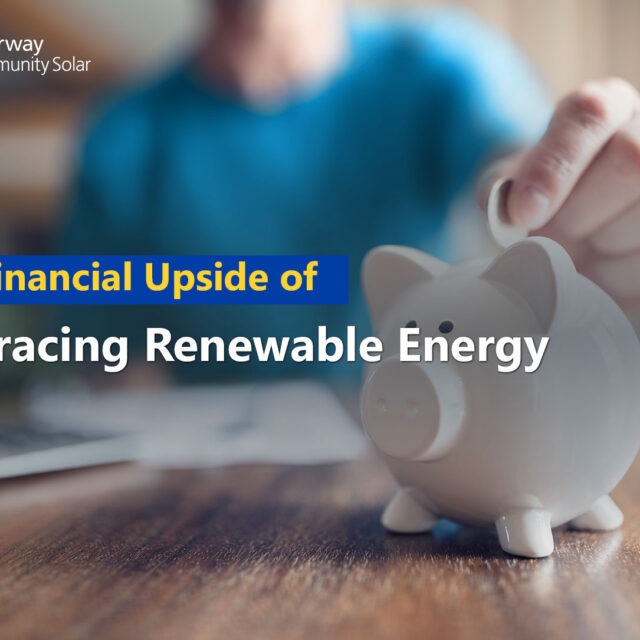
Congratulations to Ronald Pedersen for winning second place in our 2019 Essay Contest Scholarship! Ronald is a Junior at Arizona State University, double majoring in Business Supply Chain Management and Sustainability. Ronald’s essay won our second place $2,500 prize – read their winning essay!
Clearway Scholarship 2019
Ronald Pedersen
Arizona State University
Renewable energy is currently one of the most important advancements taking place in the modern world. Aside from being one of the hottest tech fields, it provides solutions to many of the problems our world is facing today. It supports a sustainable future by reducing our carbon footprint drastically, allowing for the implementation of more independent and reliable smart grids, and providing millions of green jobs to boost our economy, thus hitting all three pillars of sustainably. While the benefits of Renewable energy seem obvious, the implementation of such a technology is not. Currently, old energy practices still hold dominant in the market place and contribute a majority of the energy we use today. According to the government’s EIA, renewable energy only accounted for about 11% of total U.S. energy consumption and about 17% of electricity generation.” (EIA, 2019) While this number is ever-increasing, more action needs to be taken to better implement renewable energy and thus surpass fossil fuels as the leading energy supplier in the U.S. Three big steps need to be taken. First and foremost, the current Solar Investment Tax Credit (ITC) needs to be continued and extended further into the future. Such an incentive needs to be coupled with corporate action and responsibility with implementation. Second, companies and government organizations need to invest in improving/creating battery storage technology to thus make renewable energy practical and reliable around the clock. Lastly, grid efficiency needs to be increased by introducing microgrids and better implementing smart grid technology for better community accessibility.
The first step that needs to be taken for renewable energy to surpass fossil fuels as the leading source of energy in the U.S is to extend the current Solar Investment Tax Credit (ITC) long enough for renewable energy companies to gain an even more permanent and dominant position in the energy market. This tax incentive, passed in 2006 under the Bush administration, is a federal policy that provides a 30% reduction in the cost associated with a solar investment. Such a policy has already proven to redefine the solar industry. According to Greentech Media, the price of solar has dropped “more than 80% and cumulative solar deployment has increased by more than 10,000 percent” since the tax incentive was passed. (Hopper, 2019) This has led to a boom in not only the solar industry, but the economy as a whole as over 200,000 jobs and more than 140 billion dollars in private investment have been created since its inception. The benefits of the Solar ITC are obvious and abundant, but those benefits can quickly come to an end in the following years. In 2020 the benefit will decrease from 30% to 26% and in 2022 the ITC will be decreased to a mere 10%. This decrease in incentive will drastically slow the solar industry and will slow the process of surpassing fossil fuels as a dominant energy source. According to the Solar Energy Industries Association, we would be losing out on about 81 gigawatts of solar deployment over the next 20 years if the Solar ITC is reduced. (SEIA, 2019) This is massive and it is vitally important that the correct steps are taken to ensure that incentive tax credits are extended at full into the future. Over 900 solar companies have already taken action by writing congress requesting that the ITC be extended, but more similar action needs to be taken by larger companies and the general public. Awareness needs to be raised in colleges and within larger corporations about the economic, environmental, and social benefits of extending such a bill. Action can be taken now. With the 2020 elections coming up, young Americans all over the country can not only vote, but advocate and participate in movements to not only continue the ITC, but to elect officials who will likewise support and implement policy supporting renewable energy. Students can meet or write with local officials and business owners to demonstrate the importance of the incentive. Regardless of how big or small the contribution is, action needs to be taken to promote smart policy. Overall, the solar ITC is a very necessary and very influential policy that needs to be extended to better implement Solar technology and to essentially surpass fossil fuels as the dominant energy source in the U.S.
The second big step in implementing renewable energy in the U.S is to develop longer-lasting and more efficient battery storage systems. While harnessing the power of wind and solar is the first important step in renewable energy usage, storing it proves to be equally important and challenging. Energy storage is extremely important for the renewable field because while we have the capacity to produce enough energy for people to use, we have to also create a way to store that energy for emergencies, low production hours (night time for solar), and consumption variations. Without this, Renewable Energy will never be able to fully compete with the consistency of our current energy production process. Currently, technology in Renewable Energy storage allows us access to limited hours of energy storage and short term protection from blackouts. Current home solar storage systems allow for basic amenities such as lights, refrigerators, and the internet to run for a significant duration, but currently, no solar storage system can store enough energy for extensive blackout situations. Tesla’s 13.5-kilowatt-hour capacity “Powerwall” provides 12 to 15 hours of average electricity usage. (Merchant, 2019) While this may seem like a significant amount of storage, it is not enough to guarantee or replace the current energy system. Companies at the forefront of battery storage, such as Tesla and Sunrun, need to continue pushing the limits of storage technology and further invest in research and development. As we see demand for solar spiking, the dependent demand for solar storage will press companies and organizations to begin the development of higher-end storage. Following this, storage implementation needs to take place. Essentially, developing higher-end storage is a major barrier for renewable energy when it comes to overtaking fossil fuels and the technology needs to be not only invested in but developed by private companies and research institutions.
The third step is to implement an efficient and reliable grid system as standard across the United States. This includes implementing smart grid technology coupled with microgrids and the benefits of renewable energy. As previously stated, harnessing solar power and storing it are two major steps in overcoming fossil fuels as the major energy source in the U.S. The next step is distributing it efficiently and reliably. The current electrical grid system in the United States is old, with some installations dating back from the 1890s. Grid updates need to be made to allow for the efficient flow of renewable energy to homes, companies, etc. This starts with the implementation of solar/wind enabled microgrids. Microgrids serve as “islands” connected to the central grid. In times of blackouts or energy inconsistency, microgrids can “disconnect” from the central grid and provide energy for the homes/facilities within its parameters. (Koehler, 2018) Such microgrids can be fueled in part or completely by local renewable sources and thus provide security and stability that our current grid system cannot. When that specific Microgrid experiences times of spiked demand or system failures, they can rely on the central grid for support. In addition, Microgrids allow communities to be self-sufficient when it comes to their energy demands. This is something that fossil fuels cannot provide since power comes from large plants and is transported through a central grid system. Parallel to the installation of microgrids needs to come to the implementation of smart grid technology. Smart grid technology is a form of digital technology that allows two-way communication between the user and the provider, thus telling the energy source exactly how much energy is needed and when energy is not needed. It includes sensors, control computers, and automation technology to improve efficiency and safety in the system. This helps prevent phantom energy from being lost in the system and can better allocate energy to facilities or microgrids that have higher demand. In addition to this, smart grids provide a more efficient flow of energy to consumers, reduce restoration times after power disturbances, and help implement large scale renewable energy. By essentially communicating demand, smart grids can predict energy spikes and provide consumers a higher level of services in conjunction with renewable sources. Overall, implementing a more efficient grid system with microgrid and smart grid technology is a crucial step in the process of renewable energy overtaking fossil fuels as the dominant energy source in the U.S.
Renewable energy is the future of not only the United States, but the entire world. The benefits of clean energy expand beyond just environmental, but also improve the economic and social state of society as a whole. Renewable technology is being implemented and improved at a drastic rate, but steps still need to be taken to replace older and less beneficial fossil fuels as the main energy source in the U.S. First, the Solar ITC needs to be expanded and supported moving forward into the future to continue investment in solar projects around the country. Second, energy storage technology needs to be invested in and improved to make renewable energy not only practical but resilient to demand fluctuations. Lastly, smart grid technology needs to be coupled with micro-grid implementation to optimize our renewable energy sources. With these steps taken, we will be closer to creating a better world for not only ourselves, but the future of the planet and those who will come to exist after us.
References
- EIA. “U.S. Energy Information Administration – EIA – Independent Statistics and Analysis.” How Much of U.S. Energy Consumption and Electricity Generation Comes from Renewable Energy Sources? – FAQ – U.S. Energy Information Administration (EIA), U.S Energy Information Administration, 4 June 2019, https://www.eia.gov/tools/faqs/faq.php?id=92&t=4.
- Hopper, Abigail Ross. “Earth to Congress: You Can Deliver a Climate Win Today.” Greentech Media, Greentech Media, 9 Sept. 2019, www.greentechmedia.com/articles/read/earth.
- Koehler, Scott. “How Solar Power Gets a Boost with Smart Grid Solutions.” Schneider Electric Blog, Schneider Electric, 4 July 2019, blog.se.com/smart-grid/2018/06/12/how-solar-power-gets-a-boost-with-smart-grid-solutions/.
- Merchant, Emma Foehringer. “Can Solar and Batteries Outlast an Extended Power Outage?” Greentech Media, Greentech Media, 14 Oct. 2019, www.greentechmedia.com/articles/read/can-solar-and-storage-weather-a-days-long-power-outage-it-depends#gs.a8t0tx.
- SEIA. “Solar Policy.” SEIA.org, Solar Energy Industries Association, 2019, www.seia.org/initiative-topic/solar-policy.









